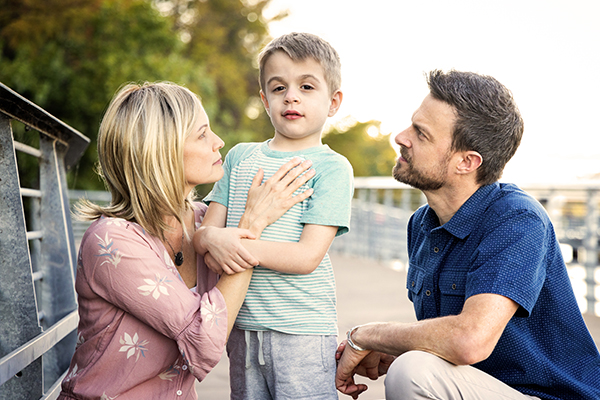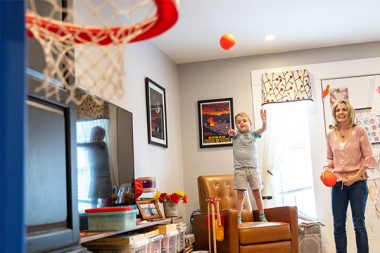Parents’ Help Simon Campaign Aims to Raise $1M to Find Cure for Son, 5
Written by |

Photo by Amy Mikler Photography
Simon Croke, middle, accompanied by his parents, Alina, left, and Jeremy Croke.
An Austin, Texas, family is putting all their effort into raising $1 million to find a treatment for their 5-year-old son, Simon Croke, who was diagnosed with Sanfilippo syndrome type B nearly three years ago.
His parents, Alina and Jeremy Croke, are leveraging their son’s semi-viral popularity — Simon hits nothing but net in shot after shot into his miniature basketball hoop — to drive donations to the Cure Sanfilippo Foundation, which funds scientific research and supports affected families. Their goal is to find an effective therapy before Simon completely loses his ability to walk, talk, and most importantly, shoot three-pointers.

Simon Croke, encouraged by his mother, Alina Croke, shoots a basketball into a child-size hoop. (Photo by Amy Mikler Photography)
The Help Simon campaign, created by the Croke family and supported by the Cure Sanfilippo Foundation, launched on World Sanfilippo Awareness Day on Nov. 16 and has raised more than $60,000 for the cause on its GoFundMe page.
“We’re largely introverted folks, and for us to be doing this campaign is extremely vulnerable, putting ourselves out there, sharing our story with the world,” Alina Croke said of the Help Simon fundraiser. “But we’ll do anything for our sweet Simon. He’s a bright light in this world.”
Children with the metabolic disorder, which causes toxic storage materials to accumulate in the brain, develop at a slower pace than their neurotypical peers and eventually begin to undergo developmental regression, wherein they lose previously acquired skills. It is unknown when this decline will start in Simon, and in an interview with Sanfilippo News, Croke emphasized that time is against them.
“I can’t help but worry every single day, that it could be the last day he does this or the last day he does that,” she said.
‘Our miracle child’
But Sanfilippo wasn’t the first health challenge the family had to face. The Crokes’ up-and-down journey with Simon started long before he was born.
Alina Croke was diagnosed with triple-negative breast cancer in January 2013, and she needed treatment immediately to stop the growth of aggressive tumor cells. Doctors recommended she start chemotherapy within three weeks, but to save her eggs for a child the couple had always wanted, she would have to wait at least 10 weeks. The Crokes ultimately opted to start cancer treatment as soon as possible.
“If there’s no mama, then there obviously aren’t any kids,” Croke said.
It was at that point the Crokes realized they may never have a biological child of their own. After eight months of grueling chemotherapy, a lumpectomy, and radiation, Alina Croke was cancer-free. Then, in 2014, she took three anti-mullerian hormone tests, which are used to measure fertility in women. The results showed that there were scant to no eggs remaining.
What they didn’t expect though, is that two years after Croke’s treatment concluded, she was pregnant with Simon. Croke jokes that Simon was the final egg “you couldn’t see.”
“I imagine a gumball machine with all white gumballs visible and then one blue one in the center that you couldn’t see,” Croke said. “That was like Simon, the egg that was like, ‘No, I’m here, come find me, please come find me. I’m here. I’m not damaged.’”
So, when the child the Crokes thought they would never have was diagnosed with a rare and fatal disease, it was especially hard to take. Croke remembers crying the entire night she found out about Simon’s unknown condition, which had caused them so much trouble for the first two and a half years of his life — and for which there was a lack of answers.
“I just cried and cried and cried,” Croke, 44, said. “He was our miracle child and to think that this miracle child is going to be taken from us … was just heartbreaking and still is.”
Dealing with the diagnosis
Croke had suspected something was wrong with her son from the beginning. Even in the womb, doctors told her Simon was stuck in a frank breech presentation, meaning his bottom was in a position to be born first rather than his head. He was not able to turn to a more natural position, and he was born a week early in an emergency cesarean section.
She’s not sure, looking back, whether that was related to Sanfilippo or not, but it was during breastfeeding that she realized things weren’t adding up.
Simon lacked the natural ability to suck, and all of the therapy in the world couldn’t fix the problem. And when, by his first birthday, he hadn’t said his first word or taken his first step, it set Croke off on a journey to get to the bottom of what was causing his issues. She checked off appointments with all the specialists and subjected Simon to a host of tests, but it wasn’t until an appointment with a pediatric geneticist 10 months later that she would find the true cause of his developmental delays.
On a routine visit to that developmental specialist, Croke received a summary of her appointment, which included notes from all the doctors Simon had seen, including the geneticist. Later at home, upon reading the report, she came across a disorder she had never heard of before — Sanfilippo syndrome. A Google search stopped her in her tracks. The disease was fatal and there was no cure.
The geneticists had tried to reach her earlier and deliver the news in a better format, but she had missed two calls from the doctor’s office because her phone was out of battery.
“We were trying to just make sense of this in our minds, and I remember saying to my husband, I just want him to be loved, to love and be loved,” Croke said.
She had an impulse to sell everything they owned, buy a motorhome, and tour the U.S. before Simon’s developmental regression caught up with him.
Instead, Croke reached out to the Cure Sanfilippo Foundation the next day and found a community of people going through the same thing.
Hope for the future
As it is now, Simon can only say a few words strung together and has difficulty dressing, toileting, and bathing on his own. But he’s still holding on to his surprising ability to shoot a basket.
“As an unsteady toddler, Simon spent hours a day sinking baskets in his Little Tikes basketball hoop,” the Crokes say on the Help Simon GoFundMe page.
“As he’s gotten older, the height of the hoop has gone up, the distance to the basket has gotten farther, and the degree of difficulty continues to increase,” the page says, noting that people “see Simon hit shot after shot and their jaws just drop.”
The family’s interaction with the nonprofit Cure Sanfilippo Foundation gave them hope that Simon could have a future. Croke added that it’s not any kind of ephemeral hope either.
“This isn’t like broad hope, we hope something comes our way. This money is being raised for these two concrete promising treatment options,” Croke said of the Help Simon fundraiser.
The first of the two experimental therapies is CLR01, a kind of “molecular tweezer” that showed “reduced neuroinflammation and amelioration of memory deficits” in MPS-IIIA (Sanfilippo syndrome subtype A) mice, the researchers wrote in their study.
Another project the Help Simon campaign is funding is researching the use of transplanted human neural stem cells to express and secrete the sulfoglucosamine sulfohydrolase enzyme Sanfilippo patients lack. ReMotor Therapeutics completed a proof-of-concept study in an animal model in April.
Neither has reached the clinical trial phase, but Glen O’Neill, the foundation’s president and co-founder, said that $1 million could help get this preclinical research into human studies quicker.
“These research projects are underway for type A, and what we want to do is we want to get them going and get them going quick for type B,” O’Neill said in a phone interview with Sanfilippo News. O’Neill started the nonprofit after his daughter, Eliza, 12, was diagnosed with the disease.
“The overall costs for these things is over $1 million, but $1 million will certainly help these get closer to a clinical trial,” he said.
It’s not guaranteed that Simon will be able to join these clinical trials down the line if the $1 million is raised because of enrollment criteria, O’Neill said. But de-risking the early science and prompting biotech support for a clinical trial that could cost upward of $10 million would give him a better chance.
The next Stephen Curry
In the meantime, the family is trying to get as many people as possible to share a three-minute video the nonprofit helped produce about the Crokes’ story, interspersed with head-scratching overhead basketball shots by the young boy.
Croke doesn’t know exactly where Simon got his impeccable hand-eye coordination from, only that he started playing with his miniature hoop just a month after his diagnosis. She suspects a combination of loving the praise he gets when he makes a basket and the therapeutic-like repetitive motion of it led him to the passion.
As he got older, his parents kept moving him back and lifting the basket higher, and he kept making the shots. During the COVID-19 pandemic, he would make 10 in a row and not stop till he hit 100.
The boy’s basketball talent drew the attention of a friend who worked for the sports blog “Busted Coverage,” and he posted it on the website’s Twitter account in March 2020, where it garnered 4,000 views. The Cure Sanfilippo Foundation, which has done similar family story videos before, thought Simon’s skill could help raise awareness and funds for research.
The organization went all in, getting help from videographer and board member Benjamin Von Wong, creating a public relations campaign, and organizing media interviews with the family.
Croke is confident they’ll reach their $1 million goal on the Help Simon page if enough people step up for an assist. Of course they want to help Simon, but it’s also for all other families going through the same thing.
“I think it’s just our natural human desire to connect with people and empathize with folks and sympathize with folks and have compassion for our story, and help us try to save our sweet little boy as well as other kids with Sanfilippo syndrome,” Croke said.
Those interested in learning more and donating can visit the Help Simon GoFundMe or the family’s Facebook page.





